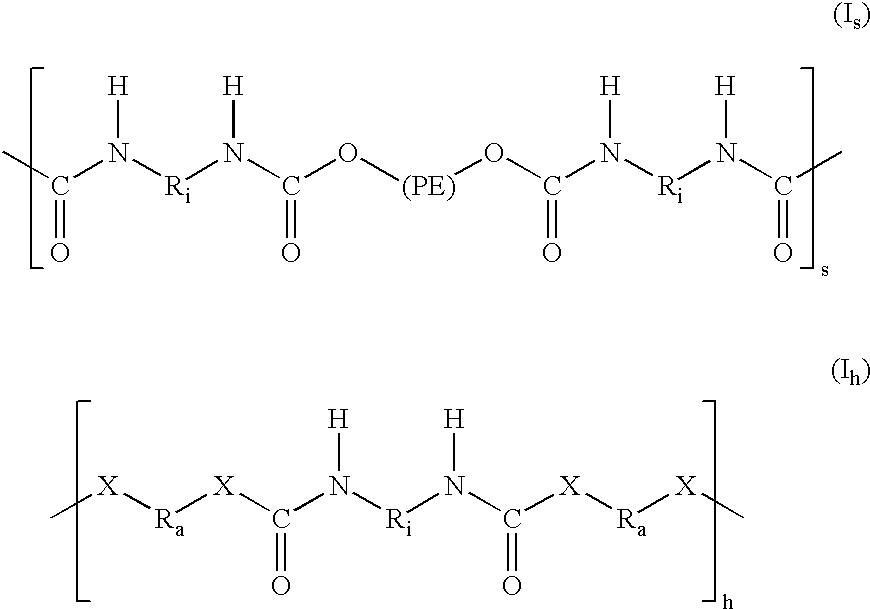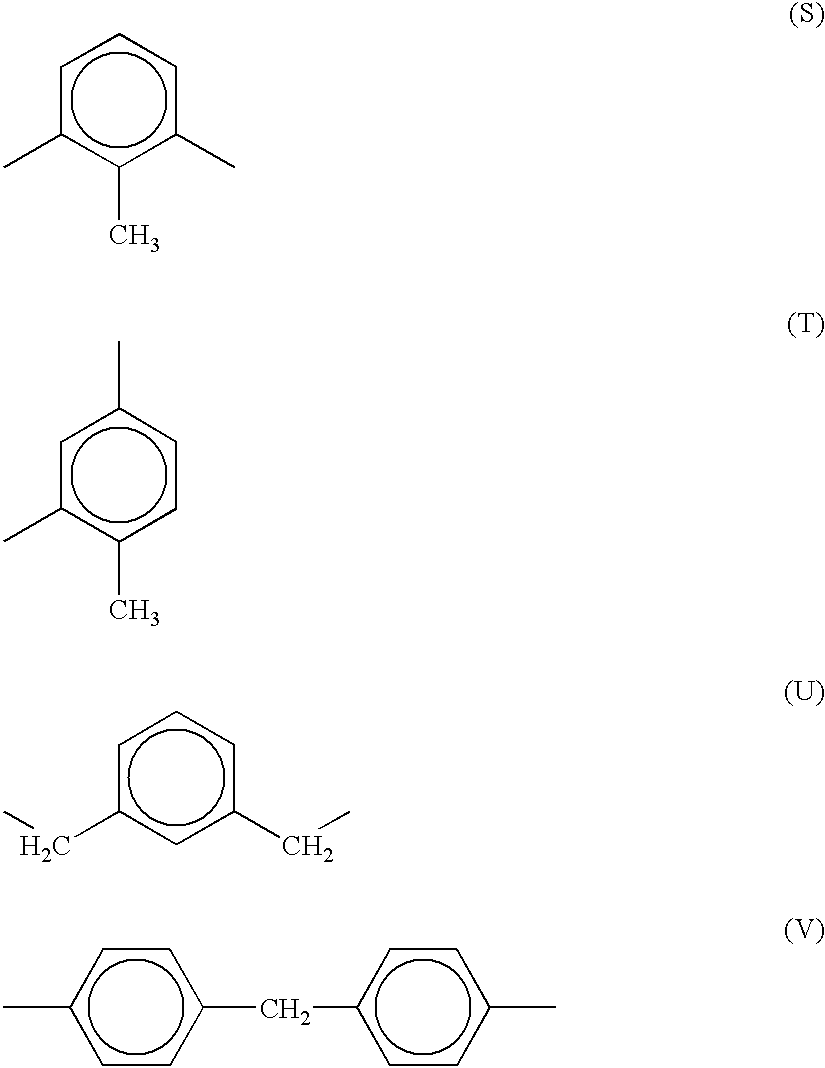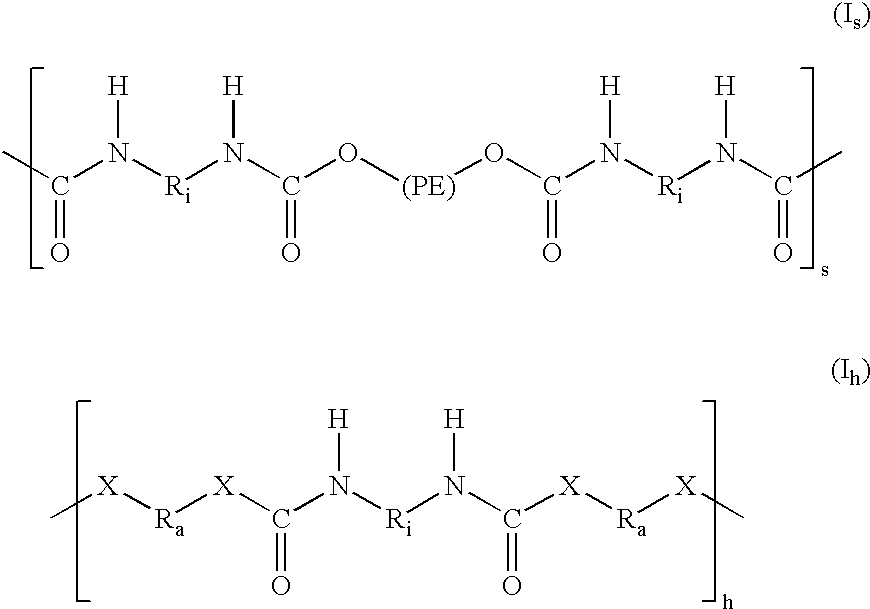Block polyurethane-ether and polyurea-ether gas separation membranes
a technology of polyurea ether and gas separation membrane, which is applied in the direction of separation process, by membrane, products, etc., can solve the problems of high gas permeation rate of prior-art gas separation membrane, limited success of membrane system, and high cost of construction, operation and maintenan
- Summary
- Abstract
- Description
- Claims
- Application Information
AI Technical Summary
Problems solved by technology
Method used
Image
Examples
example 1
A flame-dried 3-necked 250 mL round bottomed flask, equipped with a mechanical stirrer, an addition funnel, and a nitrogen inlet, was charged with 15.0 g (0.0075 mol) of PPG-2000 (hydroxyl terminated poly-1,2-propylene glycol, MW˜2000), 0.10 g of T-12 catalyst (dibutyltindilaurate), and 80 mL of NMP. The solution was stirred at room temperature and 3.785 g (0.0225 mol) of HDI [hexane-1,6-diisocyanate], dissolved in 20 mL of NMP, were added drop-wise to the solution over a 5-minute period. The solution was gradually heated to around 90° C. and kept at this temperature for 2 hours under a nitrogen atmosphere. The solution was then cooled to room temperature and 1.352 g (0.015 mol) of 1,4-butane diol, dissolved in 20 mL of NMP, were added drop-wise over a 5-minute period. The polymer solution was then reheated to 80-90° C. for 2 hours.
After cooling the polymer solution to room temperature, the polyurethane-ether was precipitated into water and ground up in a blender. The polymer was fi...
example 2
A flame-dried 3-necked 250 mL round bottomed flask, equipped with a mechanical stirrer, an addition funnel, and a nitrogen inlet, was charged with 15.0 g (0.005 mol) of PPG-3000 (hydroxyl terminated poly-1,2-propylene glycol, MW˜3000), 0.10 g of T-12 catalyst (dibutyltindilaurate), and 80 mL of NMP. The solution was stirred at room temperature and 2,523 g (0.015 mol) of HDI [hexane-1,6-diisocyanate], dissolved in 20 mL of NMP, was added drop wise to the solution over a 5-minute period. The solution was gradually heated to around 90° C. and kept at this temperature for 2 hours under a nitrogen atmosphere. The solution was then cooled to room temperature and 1.022 g (0.010 mol) of 1,5-diaminopentane, dissolved in 20 mL of NMP, was added drop wise over a 5-minute period. The polymer solution was then reheated to around 80-90° C. for 2 hours.
After cooling the polymer solution to room temperature, the polyurea-ether was precipitated into water and ground up in a blender. The polymer was ...
examples 3-14
Various polymers were made using the ingredients depicted in Table 1 utilizing the synthesis techniques of Example 1 and Example 2. Dense films were either cast from solution or melt pressed to form films for permeation testing. Gas permeation results are shown in Table 1.
It should be noted that the gas permeabilities could also be tested at other suitable temperatures and / or pressures. Typically, the membranes are used to separate gases which are at about 0° C. to about 120° C. Additionally, the membranes of this invention may vary in thickness and can be of about 0.00005 mm about 0.30 mm or of other thickness known or used by one skilled in the art.
TABLE 1ExampleDiol orDiiso-Wt %P(CO2)P(H2)P(CO2) / Temp#DiaminePolyethercyanateSS(Ba)(Ba)P(H2)(° C.) 1APPG-Z75527806.6252000 2CPPG-Z8158676.67.7223000 3ATer-2000Z70271446.225 4ATer-2900Z71319486.625 5BPEG-Z7816722.57.4351500 6BTer-2000Z70422656.525 7BPPG-Z7250185.55.9253000 8BPPG-U7342978.75.4252000 9BPPG-V72317555.8252000 10*CPEG-Z721101...
PUM
| Property | Measurement | Unit |
|---|---|---|
| weight % | aaaaa | aaaaa |
| temperatures | aaaaa | aaaaa |
| thickness | aaaaa | aaaaa |
Abstract
Description
Claims
Application Information
 Login to View More
Login to View More - R&D
- Intellectual Property
- Life Sciences
- Materials
- Tech Scout
- Unparalleled Data Quality
- Higher Quality Content
- 60% Fewer Hallucinations
Browse by: Latest US Patents, China's latest patents, Technical Efficacy Thesaurus, Application Domain, Technology Topic, Popular Technical Reports.
© 2025 PatSnap. All rights reserved.Legal|Privacy policy|Modern Slavery Act Transparency Statement|Sitemap|About US| Contact US: help@patsnap.com



